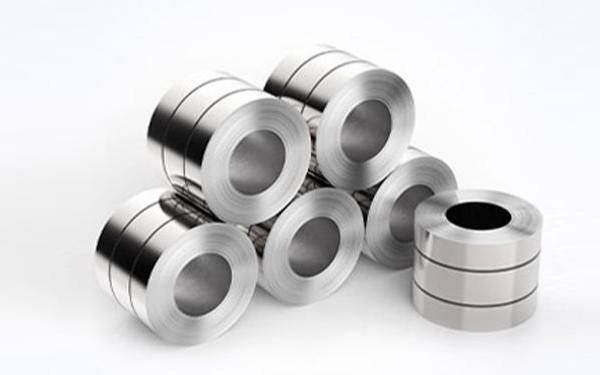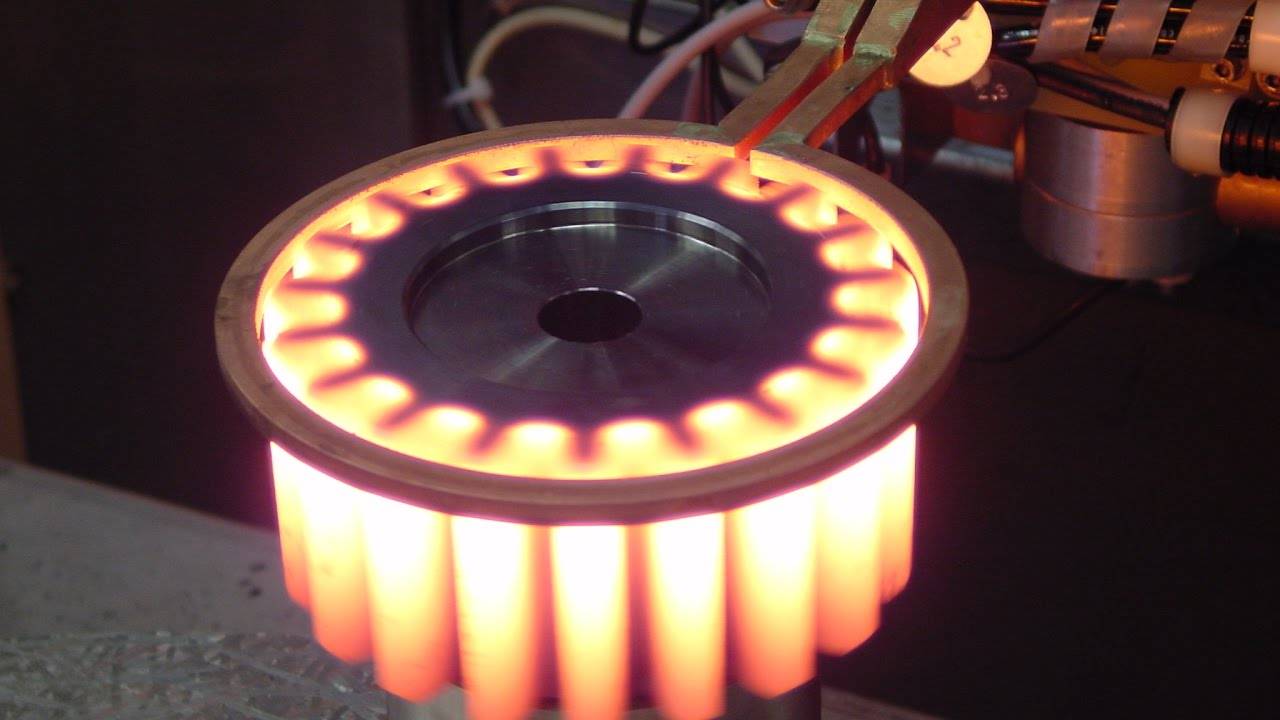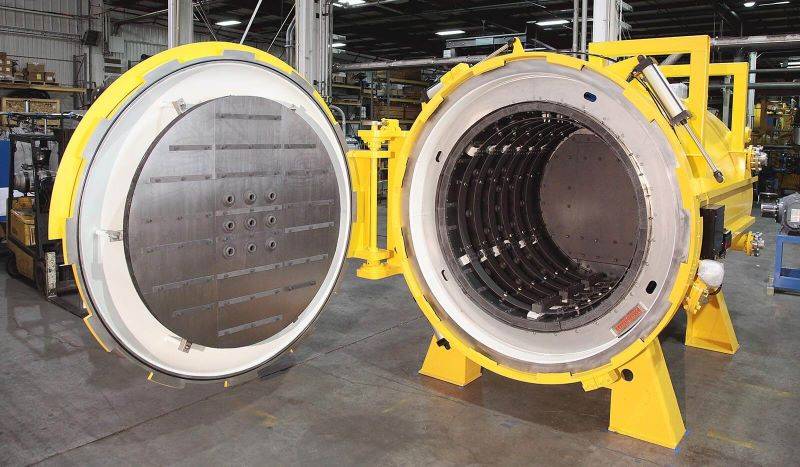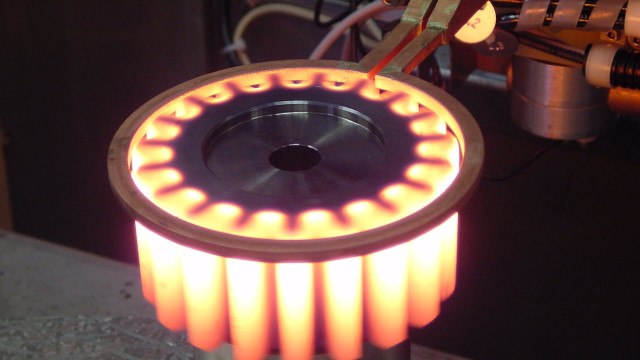Material and Gas Selection
Titanium Alloy Treatment
When treating titanium alloys in a vacuum furnace, it is crucial to avoid using nitrogen as a cooling gas. This precaution is necessary because titanium exhibits a high affinity for nitrogen, particularly at elevated temperatures. At such temperatures, titanium and nitrogen undergo a chemical reaction, forming a golden-colored compound known as titanium nitride. This reaction not only alters the surface properties of the titanium alloy but also introduces potential structural changes that could compromise the material's integrity and performance.
Titanium's reactivity with nitrogen underscores the importance of selecting appropriate cooling gases for vacuum heat treatment processes. Given titanium's industrial significance in aerospace and biomedical applications, ensuring the correct handling and treatment of this material is paramount. The formation of titanium nitride can lead to undesirable surface hardening and embrittlement, which are particularly detrimental in high-stress applications where material strength and durability are critical.
To mitigate these risks, argon is typically chosen as the cooling gas for titanium alloys in vacuum furnaces. Argon, being an inert gas, does not react with titanium under normal conditions, thereby preventing the formation of titanium nitride and ensuring the material's structural and surface integrity remains intact. This practice aligns with the broader principles of vacuum heat treatment, which emphasize the importance of material and gas selection to achieve optimal treatment outcomes.
Cooling Gas Selection
The selection of cooling gases in vacuum heat treatment is crucial for maintaining the integrity and properties of the treated materials. For steel, a cooling gas with a purity of 99.995% nitrogen is typically preferred. This high level of purity ensures that the steel does not react with the gas, thereby preserving its structural and mechanical properties during the cooling process.
In the case of high-temperature alloys, the requirements are even more stringent. These alloys often require a cooling gas with a purity of 99.999% nitrogen or argon. The higher purity levels are necessary to prevent any potential contamination that could compromise the alloy's performance at elevated temperatures. Argon, in particular, is often chosen for its inert properties, which minimize the risk of chemical reactions with the alloy.
For titanium alloys, the choice of cooling gas is particularly critical. Unlike steel and high-temperature alloys, titanium reacts with nitrogen at high temperatures, forming a golden-colored titanium nitride. Therefore, a cooling gas with a purity of 99.995% argon is recommended for titanium alloys. Argon's inert nature ensures that the titanium remains unreactive, preventing the formation of titanium nitride and maintaining the alloy's desired properties.
| Material | Recommended Cooling Gas | Purity Level | Rationale |
|---|---|---|---|
| Steel | Nitrogen | 99.995% | High purity prevents reactions, maintains structural integrity. |
| High-Temperature Alloys | Nitrogen or Argon | 99.999% | Higher purity prevents contamination, maintains performance at high temps. |
| Titanium Alloys | Argon | 99.995% | Inert gas prevents reaction with titanium, avoids formation of nitride. |
This table summarizes the key considerations in selecting cooling gases for different materials in vacuum heat treatment, highlighting the importance of gas purity and inertness in preserving the material's properties.

Equipment and Process Parameters
Vacuum Furnace Activity Articulation
Vacuum furnace activity articulation encompasses a variety of design elements that ensure the furnace operates efficiently and effectively. One critical aspect is the selection of sealing mechanisms, particularly the use of O-type rubber rings, which provide a robust and reliable seal against vacuum conditions. These seals are essential for maintaining the integrity of the vacuum environment within the furnace.
In addition to sealing, the cooling system plays a pivotal role in the furnace's operation. Some vacuum furnaces incorporate water cooling, which is crucial for rapid temperature control and stabilization. This dual approach of sealing and cooling ensures that the furnace can handle a wide array of thermal processes, from heat treatment to annealing, with precision and consistency.
The design of vacuum furnaces is highly adaptable, allowing for customization to meet specific industrial needs. This adaptability is driven by the need for:
- Process Control: Ensuring accuracy in temperature and vacuum levels.
- Process Repeatability: Maintaining consistent outcomes across multiple cycles.
- Up-time Reliability: Ensuring the furnace operates without interruptions.
- Adaptability: Being able to handle new materials and processes as they emerge.
- Integration: Seamlessly fitting into existing manufacturing workflows.
- Environmental Impact: Reducing emissions and energy consumption.
These factors collectively contribute to the economic advantage of vacuum processing, enhancing productivity, minimizing distortion, and reducing cycle times.
Pressure Rise Rate
The pressure rise rate is a critical parameter in the operation of domestic vacuum furnaces, particularly in the context of heat treatment processes. This rate quantifies the increase in pressure within the furnace over a specified period, typically measured in Pascals per hour (Pa/h). For domestic vacuum furnaces, the recommended pressure rise rate should not exceed 1.33 Pa/h. This standard ensures that the furnace maintains a stable vacuum environment, which is essential for achieving consistent and high-quality heat treatment results.
In contrast, some foreign companies have established more stringent specifications, setting the pressure rise rate at 0.67 Pa/h. This lower threshold reflects a higher level of precision and control in their vacuum furnace operations. Achieving such a low pressure rise rate requires advanced equipment and meticulous process management. The benefits of adhering to these tighter specifications include improved material homogeneity, reduced risk of contamination, and enhanced overall process efficiency.
| Specification Type | Pressure Rise Rate (Pa/h) |
|---|---|
| Domestic Standard | 1.33 |
| Foreign Standard | 0.67 |
Understanding and adhering to these pressure rise rate standards is crucial for maintaining the integrity of the vacuum environment during heat treatment. It ensures that the materials being processed are exposed to consistent conditions, leading to predictable and reliable outcomes.
Heating and Cooling Equipment
The vacuum tempering furnace is equipped with advanced fast cooling systems designed to expedite the cooling process, ensuring precise control over temperature gradients. These cooling systems typically operate with a cooling water pressure exceeding 0.2 MPa, which is crucial for maintaining the integrity and structural properties of the treated materials. The flow rate of the cooling water is also adjustable, allowing for fine-tuning based on the specific requirements of the material being processed.
For instance, when dealing with titanium alloys, the cooling process must be meticulously controlled to prevent the formation of titanium nitride, which can occur if nitrogen is used as the cooling gas at high temperatures. Instead, argon, with its higher purity, is preferred for its inert properties, ensuring that the material's characteristics are preserved without chemical reactions.
| Material | Cooling Gas | Purity |
|---|---|---|
| Steel | Nitrogen | 99.995% |
| High-Temperature Alloy | Nitrogen or Argon | 99.999% |
| Titanium Alloy | Argon | 99.995% |
This table highlights the importance of selecting the appropriate cooling gas based on the material being treated, ensuring optimal performance and longevity of the vacuum tempering furnace.
Workpiece Handling and Treatment
Quenching in Vacuum State
Quenching workpieces in a vacuum state requires the use of specialized vacuum quenching oil, which is characterized by its low full vapor pressure. This oil is essential for maintaining the integrity and quality of the workpiece during the quenching process. The vacuum environment ensures that the atmosphere does not interact with the material, preventing oxidation and preserving the surface finish of the workpiece.
In a vacuum purge furnace, the workpiece is heated to a phase change temperature, which varies depending on the specific requirements of the quenching process. This heating phase is crucial for the transformation of the entire heated mass. Once the desired temperature is reached, the workpiece is cooled rapidly to trap chemical elements that have diffused at high temperatures. This rapid cooling is facilitated by the vacuum quenching oil, which ensures that the cooling rate is sufficient to achieve the desired mechanical characteristics.
The advantages of vacuum quenching are manifold. Firstly, the treated parts do not oxidize, which means they remain shiny and retain their aesthetic quality. Secondly, the process contributes to increasing certain mechanical characteristics of the hardened part, such as tensile strength and hardness. This is due to the tensions that are created in the crystalline meshes as a result of the rapid cooling and trapping of chemical elements.

In summary, vacuum quenching is a sophisticated process that leverages the properties of vacuum quenching oil to achieve optimal results. The controlled atmosphere and rapid cooling ensure that the workpiece not only maintains its surface quality but also enhances its mechanical properties.
Vacuum Protection
Vacuum furnace protection is a critical aspect of maintaining the integrity and efficacy of heat treatment processes. The furnace should ideally operate in a vacuum state or be filled with pure nitrogen to ensure optimal conditions. This approach prevents the absorption of gases and moisture, which can compromise the quality of the heat treatment.
In a vacuum state, the absence of atmospheric gases eliminates the risk of chemical reactions that could alter the properties of the materials being treated. Additionally, maintaining a vacuum helps to minimize the presence of moisture, which can lead to oxidation and other undesirable effects.
When using pure nitrogen, it is essential to ensure that the gas is of the highest purity available, typically 99.995% or higher. This high level of purity ensures that any residual gases within the nitrogen do not interact with the materials in the furnace, thereby preserving their intended characteristics.
The choice between operating in a vacuum or using pure nitrogen depends on the specific requirements of the heat treatment process. For instance, titanium alloys, which are prone to reacting with nitrogen at high temperatures, are often treated in a vacuum to avoid the formation of titanium nitride.
In summary, maintaining the furnace in a vacuum or with pure nitrogen is crucial for preventing gas and moisture absorption, thereby ensuring the quality and consistency of the heat treatment process.
Heating and Outgassing
During the heating phase of vacuum heat treatment, both the workpiece and the materials within the furnace undergo a process known as outgassing. This phenomenon significantly impacts the vacuum degree within the chamber. Outgassing refers to the release of gases that were previously absorbed or adsorbed by the materials. These gases can originate from various sources, including the workpiece itself, the furnace walls, and other components within the chamber.
The primary gases released during outgassing often include water vapor, hydrogen, carbon dioxide, and hydrocarbons. These gases are typically absorbed or adsorbed onto the surfaces of the materials at room temperature. When the furnace is heated, the increased temperature causes these gases to desorb and escape into the vacuum chamber, thereby reducing the overall vacuum degree.
To mitigate the effects of outgassing, several strategies can be employed. For instance, pre-pumping the furnace to a pressure of around 6.67Pa before initiating the heating process can help reduce the initial gas load. Additionally, using high-purity materials and maintaining a clean furnace environment can minimize the amount of outgassing.
Outgassing is a critical consideration in vacuum heat treatment, as it directly influences the effectiveness of the process. A higher vacuum degree ensures better control over the heating environment, leading to more consistent and predictable results. Therefore, understanding and managing outgassing is essential for achieving optimal outcomes in vacuum heat treatment.
Heating Temperature
The heating temperature for vacuum tempering, vacuum annealing, vacuum solution treatment, and vacuum aging processes is generally consistent with that used in conventional heat treatments. This consistency ensures that the material undergoes the same thermal transformations, maintaining its structural integrity and mechanical properties.
In vacuum heat treatment, the controlled atmosphere within the furnace prevents oxidation and contamination, allowing for precise temperature control. This is crucial for achieving uniform heating across the workpiece, which is essential for the desired microstructural changes.
For instance, in the case of titanium alloys, the heating temperature during vacuum treatment is carefully calibrated to avoid the formation of titanium nitride, which can occur if nitrogen is present at elevated temperatures. This careful calibration ensures that the alloy's properties are preserved, and the final product meets the required specifications.
| Process Type | Conventional Temperature | Vacuum Temperature |
|---|---|---|
| Vacuum Tempering | 400°C - 650°C | 400°C - 650°C |
| Vacuum Annealing | 800°C - 1000°C | 800°C - 1000°C |
| Vacuum Solution Treatment | 950°C - 1200°C | 950°C - 1200°C |
| Vacuum Aging | 450°C - 600°C | 450°C - 600°C |
The table above illustrates the typical temperature ranges for these processes, showing that the vacuum environment does not alter the fundamental heating requirements but rather enhances the purity and control of the treatment. This consistency in temperature ensures that the benefits of vacuum heat treatment, such as reduced surface contamination and improved mechanical properties, are fully realized.’

Initial Setup and Preparation
Pre-Pumping Before Heating
After placing the workpiece into the vacuum furnace, it is standard practice to pre-pump the chamber to a pressure of approximately 6.67 Pa before initiating the heating process. This step is crucial for several reasons:
-
Reduction of Contaminants: Pre-pumping helps in significantly reducing the concentration of residual gases and vapors within the furnace chamber. This is essential as these contaminants can react with the workpiece at high temperatures, leading to undesirable surface reactions or embrittlement.
-
Enhanced Thermal Efficiency: By achieving a lower initial pressure, the furnace can reach the desired operating vacuum level more quickly once the heating begins. This enhances the overall thermal efficiency of the process, allowing for more controlled and uniform heating.
-
Outgassing Prevention: The pre-pumping phase also aids in minimizing outgassing from the workpiece and furnace materials during the subsequent heating cycle. Outgassing can lead to a rise in pressure within the chamber, which can affect the integrity and quality of the heat treatment.
In summary, pre-pumping to 6.67 Pa sets the stage for a more controlled and effective vacuum heat treatment process, ensuring that the workpiece undergoes minimal exposure to potentially harmful contaminants and achieving optimal thermal conditions.
Related Products
- Electric Heated Hydraulic Vacuum Heat Press for Lab
- Vacuum Hot Press Furnace Machine Heated Vacuum Press
- Vacuum Heat Treat and Pressure Sintering Furnace for High Temperature Applications
- Vacuum Hot Press Furnace Heated Vacuum Press Machine Tube Furnace
- Lab-Scale Vacuum Induction Melting Furnace























